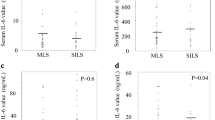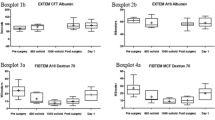Abstract
Background: Although the pneumoperitoneum decreases venous reflux from the lower extremities, the rate of thromboembolic complcations seems to be lower after laparoscopic than after conventional procedures. Therefore, it has been assumed that laparoscopic surgery better preserves the intravasal fibrinolytic capacity. The aim of this study was to determine the influence of the operative technique on intravasal fibrinolytic capacity in colorectal resection. Methods: Randomized controlled trial conducted in parallel with the multicenter trial LAPKON II comparing the long-term effects of elective laparoscopic (group I) and conventional (group II) resections for colorectal cancer. Blood samples were taken from 30 patients preoperatively, at the beginning and end of surgery as well as 2, 8, and 24 hr postoperatively. Activities and concentrations of tissue plasminogen activator (tPA), plasminogen activator inhibitor type 1 (PAI-1), tPA/PAI complex, fibrinogen, and D-dimers were determined in all specimen with ELISA tests. Area under the curve values (AUC) were calculated for all parameters. Results: Patient characteristics and indication for surgery were not different between both groups. Preoperative values of fibrinolytic parameters were similar in both groups. Postoperatively, tPA activity decreased significantly in both groups, but AUC values for tPA and PAI-1 activity (p = 0.23; p = 0.68); concentration of tPA, PAI-1, and tPA/PAI complex (p = 0.52; p = 0.78; p = 0.95); and concentration of fibrinogen and D-dimers (p = 0.67; p = 0.71) did not differ between the groups. Conclusions: An intravasal fibrinolytic "shutdown" occurs not only after conventional but also after laparoscopic colorectal resection. Both operative techniques had similar effects on postoperative intravasal fibrinolytic capacity. Therefore, the lower incidence of thromboembolic complications after laparoscopic colorectal resections does not seem to be caused by a lesser depression of the intravasal fibrinolytic capacity.
Similar content being viewed by others
Author information
Authors and Affiliations
Rights and permissions
About this article
Cite this article
Neudecker, J., Junghans, T., Ziemer, S. et al. Prospective randomized trial to determine the influence of laparoscopic and conventional colorectal resection on intravasal fibrinolytic capacity. Surg Endosc 17, 73–77 (2003). https://doi.org/10.1007/s00464-002-9028-y
Received:
Accepted:
Published:
Issue Date:
DOI: https://doi.org/10.1007/s00464-002-9028-y




